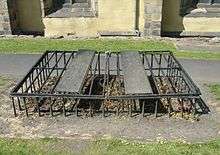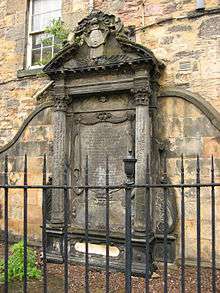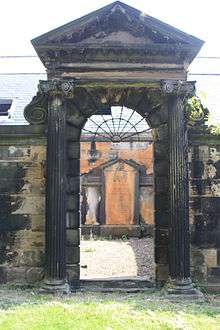Greyfriars Kirkyard
|
Greyfriars Kirkyard | |
| Details | |
|---|---|
| Established | 1561 - 1562 |
| Location | Old Town, Edinburgh |
| Country | Scotland |
| Type | Public |
| Owned by | City of Edinburgh Council |
| Size | ? |
Greyfriars Kirkyard is the graveyard surrounding Greyfriars Kirk in Edinburgh, Scotland. It is located at the southern edge of the Old Town, adjacent to George Heriot's School. Burials have been taking place since the late 16th century, and a number of notable Edinburgh residents are interred at Greyfriars. The Kirkyard is operated by City of Edinburgh Council in liaison with a charitable trust, which is linked to but separate from the church. The Kirkyard and its monuments are protected as a category A listed building.[1]
History
Greyfriars takes its name from the Franciscan friary on the site (the friars of which wore grey robes), which was dissolved in 1559. The churchyard was founded in 1561.
Because it is thoct gude that thair be na buriall within the Kirk, and that the kirk-zaird is nocht of sufficient rowme for bureing of the deid, and for esdrewing of the savour and inconvenientis that may follow thairupon in the heit of somer, it would be providit that ane buriall place be maid farrer from the myddis of the town, sic as in the Greyfreir zaird and the somyn biggit and maid close.[2] |
Because it is thought beneficial that there should be no more burials within the church [ie St Giles], and because that kirkyard is not thought to have sufficient room for burying the dead, and taking into consideration the smell and inconvenience in the heat of summer, it would be provided [by the council] that a burial place be made further from the middle of town, such as in Greyfriars yard, and the same [should be] built up and made secure. |

The Kirkyard was involved in the history of the Covenanters. The Covenanting movement began with signing of the National Covenant in Greyfriars Kirk on 28 February 1638. Following the defeat of the militant Covenanters at Bothwell Brig in 1679, some 1200 Covenanters were imprisoned in a field to the south of the churchyard. When, in the 18th century, part of this field was amalgamated into the churchyard as vaulted tombs the area became known as the "Covenanters' Prison".
During the early days of photography in the 1840s the kirkyard was used by David Octavius Hill and Robert Adamson as a setting for several portraits and tableaux such as The Artist and The Gravedigger.
Greyfriars Bobby
The graveyard is associated with Greyfriars Bobby, the loyal dog who guarded his master's grave. Bobby's headstone at the entrance to the Kirkyard, erected by the Dog Aid Society in 1981, marks his actual burial place in an unconsecrated patch of the Kirkyard - a peculiarity which has led to many misunderstandings and fictions about his burial. The dog's statue is opposite the graveyard's gate, at the junction of George IV Bridge and Candlemaker Row. The grave of Edinburgh police officer John Gray, where the dog famously slept for 13 years, lies on the eastern path, some 30m north of the entrance. The stone is modern, the grave originally being unmarked.
Monuments

Enclosed vaults are found mainly on the south edge of the graveyard and in the "Covenanters' Prison". These either have solid stone walls or iron railings and were created as a deterrent to grave robbing, which had become a problem in the eighteenth century. Greyfriars also has two low ironwork cages, called mortsafes. These were leased, and protected bodies for long enough to deter the attentions of the early nineteenth-century resurrection men who supplied Edinburgh Medical College with corpses for dissection.
Notable monuments include the Martyr's Monument, which commemorates executed Covenanters. The Italianate monument to Sir George Mackenzie was designed by the architect James Smith, and modelled on the Tempietto di San Pietro, designed by Donato Bramante.[3] Duncan Ban MacIntyre's memorial was renovated in 2005, at a cost of about £3,000, raised by a fundraising campaign of over a year.[4] The monument of John Byres of Coates, 1629, was one of the last works of the royal master mason William Wallace.
Notable burials




(note-CP denotes graves within the sealed south-west section known as the Covenanter's Prison)
- William Adam (architect) (1689–1748), with his son John Adam (architect) (1721–1796)
- William Adam of Blair Adam (1751–1839), judge
- Alexander Adie FRSE (1775-1859) optical instrument maker
- David Aikinhead (1566–1637), twice Lord Provost of Edinburgh, 1620–22 and 1625–30
- William Annand (1633–1681), minister and Dean of St Giles Cathedral
- John Beugo (1759–1841), engraver
- Joseph Black (1728–1799), physician (CP)
- Rev Hugh Blair (1718–1800)
- Sir James Hunter Blair, 1st Baronet (1741-1787)
- Robert Blair, Lord Avontoun (1741–1811) judge (CP)
- Very Rev Andrew Brown (1763–1834) minister and historian of Nova Scotia
- George Buchanan (died 1582), historian and reformer
- James Burnett, Lord Monboddo (1714–1799) judge (unmarked)
- Robert Cadell (1788–1849), publisher
- Archibald Campbell, 9th Earl of Argyll (1629–1685), nobleman
- Aglionby Ross Carson FRSE (1780–1850), rector of the High School 1820-1845, author
- William Carstares (1649–1715), churchman and statesman
- Colonel Francis Charteris (1675–1732), notorious rake and member of the "Hell-fire" club
- Prof Alexander Christison FRSE (1753–1820)
- William Coulter, Lord Provost of Edinburgh (1808–1810)
- Bishop William Cowper (1568–1619)
- James Craig (1739–1795), architect and designer of Edinburgh's New Town
- William Creech (1745–1815), bookseller and Lord Provost of Edinburgh
- Andrew Crosbie (1736–1785), lawyer and founding Fellow of the Royal Society of Edinburgh
- Sir Hugh Cunningham of Bonnington (1643–1710), Lord Provost of Edinburgh 1702-4
- Prof Andrew Dalzell, FRSE Professor of Greek at Edinburgh University (1742–1806)
- Admiral Sir Charles Douglas, 1st Baronet (1727–1789)
- James Douglas, 4th Earl of Morton (died 1581), Regent of Scotland
- Very Rev John Drysdale FRSE DD (1718–1788) twice Moderator of the Church of Scotland in both 1773 and 1784, son-in-law to William Adam and buried in the Adam mausoleum
- Prof George Dunbar (classical scholar) (1777–1851)
- John Erskine (theologian) (1721–1803)
- Mary Erskine (1629–1708), founder of The Mary Erskine School (CP)
- Sir David Falconer (1640–1685), judge
- Sir James Falconer of Phesdo (1648–1706), judge and Senator of the College of Justice
- Sir Adam Ferguson (1770–1854) soldier son of Adam Ferguson (CP)
- James Ferguson of Pitfour (1735-1820)
- Admiral John Macpherson Ferguson (1784–1855) younger son of Adam Ferguson (CP)
- Duncan Forbes, Lord Culloden (1685–1747), politician and judge.
- Sir William Forbes, 6th Baronet of Monymusk and Pitsligo FRSE (1739-1806) and his son Sir William Forbes, 7th Baronet (1773-1828), banker
- Sir James Forrest, 1st Baronet (1780–1860), Lord Provost of Edinburgh 1837-43
- Francis Garden, Lord Gardenstone (1721-1793) law lord (unmarked grave)
- William Ged (1699–1749), inventor of stereotyping (unmarked grave)
- Walter Geikie (1795–1837), artist
- Adam Gillies, Lord Gillies (1760–1842), judge (CP)
- Dr John Gordon (1786–1818), anatomist and anti-phrenologist
- Lewis Duncan Brodie Gordon (1815–1876) civil engineer
- Admiral Alexander Graeme (1741–1818), naval officer
- James Gillespie Graham (1777–1855), architect (CP)
- Lord Patrick Grant (1691–1754), judge (CP)
- Robert Hamilton (advocate) FRSE (1763-1831) friend of Sir Walter Scott
- Matthew Hardie (1755–1826) the Scottish Stradivari
- Alexander Henderson (died 1646), churchman and statesman
- Thomas Henderson FRSE unmarked within the grave of his father-in-law Alexander Adie
- Rev Prof John Hill FRSE (1747-1805) classicist
- Vice Admiral Sir John Home of Blackadder (died 1803)
- John Hope (botanist) (1725-1786)
- Sir Thomas Hope, 1st Baronet (1573–1646)
- William Howison (1798–1850), engraver
- Alexander Gibson Hunter of Blackness (1771–1812) book collector and publisher in partnership with Archibald Constable
- James Hutton (1726–1797), geologist (CP)
- Gilbert Innes of Stow (died 1832)
- George Jamesone (1587–1644) Scotland's foremost 17th-century portrait artist
- John Kay (caricaturist) (1742–1826)
- Robert Kerr (1759–1813) scientific author
- Sir John Leach (1760–1834) judge, buried in the Adam mausoleum
- John Learmonth of Dean (1789–1858), Lord Provost of Edinburgh 1831-33 (CP)
- William Littil or Little (died 1601) twice Lord Provost of Edinburgh 1586 and 1591.
- Sir George Lockhart (1630–1689), murder victim buried in Mackenzie's tomb
- Thomas McCrie (1772–1835), historian, and his son Thomas M'Crie the Younger (1797–1875)
- Alexander MacDuff of Bonhard FRSE (1816-1866)
- William McGonagall (1825–1902), poet (unmarked grave)
- Duncan Ban MacIntyre (1724–1812), Gaelic poet
- Colin MacLaurin (1698–1746), mathematician
- Sir George Mackenzie (1636–1691), Lord Advocate
- Henry Mackenzie (1745–1831), writer and author of The Man of Feeling
- Sir James McLurg of Vogrie (1629–1717), Dean of Guild, philanthropist (CP)
- John Manderston, Lord Provost of Edinburgh 1819–21
- Sir John Medina (1659–1710) prominent artist (the "sunken" vault on the east side)
- Patrick Miller of Dalswinton (1731–1815) steamship inventor
- Robert Scott Moncrieff (1793–1869) advocate and amateur artist (CP)
- Dr Alexander Monro (1697–1767) and his son Alexander (1733–1817), famed anatomists
- Sir Harry Munro, 7th Baronet (1720–1781) military leader during the Rebellion of 1745
- Sir Archibald Muir, twice Lord Provost of Edinburgh 1691–92 and 1696–98
- Prof Alexander Murray (1775–1813)
- John Mylne (1611–1667), mason and architect
- Sir William Newbigging FRSE (1772–1852), physician
- Alexander Nisbet (1657–1725), antiquarian and author of A System of Heraldry (grave location unclear)
- William Oliphant, Lord Newton (1561–1628), judge
- Archibald Pitcairne (1652–1713), physician
- Captain John Porteous (c. 1695–1736), soldier and lynching victim, after whom the Porteous Riots are named
- Allan Ramsay (1686–1758), poet
- General Henry James Riddell (died 1861) commander in chief of the Scottish army
- William Robertson D.D. (1721–1793), historian
- George Romanes FRS (1848–1894) (memorial only)
- Thomas Ruddiman (1674–1757), classical scholar and grammarian
- Sir William Scott of Thirlestane (1670–1725) landowner and poet (CP)
- Sir Robert Sibbald (1641–1722) physician and botanist
- Henry Siddons (1774–1815) failed actor son of Sarah Siddons, died whilst visiting Edinburgh.
- Sir James Skene (died 1633) President of the College of Justice
- John Skene, Lord Curriehill (d.1617)
- William Smellie (encyclopedist) (1740–1795) creator of the Encyclopaedia Britannica
- Sir James Spittal (1769-1842), Lord Provost of Edinburgh 1833 until 1837
- James Stirling (1692–1770), mathematician
- Sir James Stirling, 1st Baronet three times Lord Provost of Edinburgh and Sir Gilbert Stirling, baronet
- Rev James Struthers (1770–1807) famous orator
- Prof John Thomson FRS FRSE (1765–1846), President of the Royal College of Surgeons of Edinburgh, President of the Royal Medical Society etc.
- Archibald Tod (died 1656), twice Lord Provost of Edinburgh 1646–48 and 1651–54
- William Tytler (1711–1792), his son Alexander Fraser Tytler (1747–1813) and grandson Patrick Fraser Tytler (1789–1849) (CP)
- William Wallace (1768–1843), mathematician
- George Watson (1654–1723), accountant and founder of George Watson's College
- James Watson (died 1722) printer and publisher. Founder of the Edinburgh Gazette and Edinburgh Courant
- John Watson W.S. (died 1762), founder of John Watson's Institution, now the Gallery of Modern Art.
- Patrick Wilson (1798–1871) architect
- Dr Robert Whytt (1714–1766) (CP)
Covenanters
The National Covenant was signed in the graveyard (as it was a place of legal free public assembly) in 1638. Whilst some depictions of the event show them leaning on table-stones, these stones did not exist at that time and the signing was done during the period of ban on central gravestones.[5]
Following the Battle of Bothwell Bridge (22 June 1679), some 1200 prisoners were brought to Edinburgh. There being too numerous for containment in the prison or castle a makeshift "prison" was formed in a field south of Greyfriars Kirkyard, to hold around 400 not containable elsewhere. This area was conveniently enclosed on two sides by the Flodden Wall and on a third side (the west) by the high enclosing wall of George Heriot's School. The fourth side faced the churchyard and was separated by an easily patrolled and guarded picket fence.[6]
The name Covenanters Prison stuck. The bulk of the area was built on by the city Bedlam (around 1690). A remaining strip of land, sandwiched between the Bedlam and George Heriot's School, was used for additional burial ground from around 1700. The style at the time was to build in enclosed vaults, and this is the dominant form in this section. As the vaults did not exist at the time of the area's prison use, despite their potential to be used as prison cells, this was never the case.
The area was open to public view until around 1990, but was thereafter sealed by City of Edinburgh Council to stem persistent vandalism and use by drug-users. By special arrangement the area is open during night-time ghost tours as the area adds greatly to the atmosphere.
Bloody MacKenzie's Tomb
The distinctive domed tomb of Sir George MacKenzie has a long association with ghost stories.
In 2004 a pair of teenagers entered the tomb via the ventilation slot to the rear (now sealed). They reached the lower vault (containing the coffins) broke the coffins open and stole a skull. Police arrived as they were playing football with the skull on the grass. The pair narrowly escaped imprisonment on the little-used but still extant charge of violation of the dead.[7]
Gallery
-
Notable burials
-

Section of the east wall
-

Monuments on the east wall
-
George Buchanan Memorial
-

Tomb of John Bayne of Pitcairlie (17thC)
-

Detail on the tomb of George Foulis, laird of Ravilstoun (d.1633) and his wife, Jane Bannatyne
-
Detail on the John Mylne Monument (17thC)
-

Martyrs' Monument (left), commemorating Covenanters who died during 'The Killing Time' (1661–88)
-

Tombstone of James Borthwick, surgeon, who died in 1676
-
Recumbent figure on the tomb of William and Clement Little, 1683
-

Gravestones in the north-west of the kirkyard, including marker for the burial site of George Watson
-

Thomas Riddell's grave is believed to be the inspiration for one of the characters in J. K. Rowling´s Harry Potter fantasy series, as the character Lord Voldemort was born as Tom Riddle
References
- ↑ "Greyfriars Churchyard". Historic Scotland. Retrieved 2010-02-18.
- ↑ Edinburgh Council Records 23rd April 1561
- ↑ Gifford, John (1989) William Adam 1689–1748, Mainstream Publishing / RIAS. pp.62–67
- ↑ http://www.spl.org.uk/news/2004_2308.html
- ↑ Greyfriars Parish Burial Records:1560-1900
- ↑ http://www.covenanter.org.uk/Greyfriars/
- ↑ http://www.theguardian.com/uk/2004/apr/24/ukcrime.scotland
External links
| Wikimedia Commons has media related to Greyfriars Kirkyard. |
Coordinates: 55°56′48″N 3°11′32″W / 55.94667°N 3.19222°W
